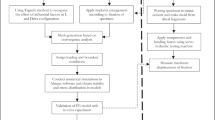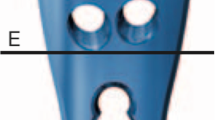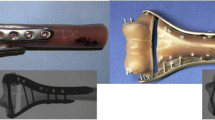Abstract
Fractures of the distal humerus are most commonly fixed by open reduction and internal fixation, using plates and screws, either in a locking or in a non-locking construct. Three different plating systems are commonly used in practice. The most important differences between them are in plate orientation, which affects both the rigidity of the osteosynthesis and invasiveness of the surgical procedure. Unfortunately, there is no common agreement between surgeons about which plate configuration brings the best clinical outcome. In this study, we investigate the theoretical rigidity of plate osteosyntheses considering two types of AO/ASIF configurations (90° angle between plates), Mayo clinic (Acumed) configuration (180° between plates) and dorsal fixation of both plates. We also compared the results for cases with and without contact between the bone fragments. In the case of no bone contact, the Mayo clinic plate configuration is found to be the most rigid, followed by both AO/ASIF plate configurations, and the least rigid system is the Korosec plate configuration. On the other hand, no significant differences between all types of fixation configurations are found in cases with contact in-between the bone fragments. Our findings show that this contact is very important and can compensate for the lack of load carrying capacity of the implants. This could therefore incite other implant fixation solutions, leading to less invasive surgical procedures and consequently improved clinical outcome.





Similar content being viewed by others
References
Baumgartner D, Lorenzetti SR, Mathys R, Gasser B, Stüssi E (2009) Refixation stability in shoulder hemiarthroplasty in case of four-part proximal humeral fracture. Med Biol Eng Comput 47:515–522
Bolsterlee B, Veeger HEJ, Chadwick EK (2013) Clinical applications of musculoskeletal modelling for the shoulder and upper limb. Med Biol Eng Comp 51:953–963
Bottlang M, Doornink J, Lujan TJ, Fitzpatrick DC, Marsh JL, Augat P, von Rechenberg B, Lesser M, Madey SM (2010) Effects of construct stiffness on healing of fractures stabilized with locking plates. J Bone Joint Surg Am 92:12–22
Carpenter JE, Wening JD, Mell AG, Langenderfer JE, Kuhn JE, Hughes RE (2005) Changes in the long head of the biceps tendon in rotator cuff tear shoulders. Clin Biomech 20:162–165
Cheng HYK, Lin CL, Lin YH, Chen ACY (2007) Biomechanical evaluation of the modified double-plating fixation for the distal radius fracture. Clin Biomech 22:510–517
Dunham CE, Takaki SE, Johnson JA, Dunning CE (2005) Mechanical properties of cancellous bone of the distal humerus. Clin Biomech 20:834–838
Ethier CR, Simmons CA (2007) Introductory biomechanics: from cells to organisms. Cambridge University Press, Cambridge
Floyd RT, Thomson CW (1998) Manual of structural kinesiology. WBC/McFraw-Hill, New York
Gefen A (2002) Computational simulations of stress shielding and bone resorption around existing and computer-designed orthopaedic screws. Med Biol Eng Comput 40:311–322
Greco GD, de Las Casas EB, Cornacchia TPM, de Magalhaes CS, Moreira AN (2012) Standard disocclusion in complete dentures supported by implants without free distal ends: analysis by the finite elements method. J Appl Oral Sci 20:64–69
Hamill J, Knutzen KM (2009) Biomechanical basis of human movement. Wolters Kluwer Health/Lippincott Williams and Wilkins, Philadelphia
Huston RL (2009) Principles of biomechanics. Taylor & Francis, London
Korner J, Lill H, Müller LP, Rommens PM, Schneider E, Linke B (2003) The LCP-concept in the operative treatment of distal humerus fractures—biological, biomechanical and surgical aspects. Injury 34:S-B20–S-B30
Korner J, Diederichs G, Arzdorf M, Lill H, Josten C, Schneider E, Linke B (2004) A biomechanical evaluation of methods of distal humerus fracture fixation using locking compression plates versus conventional reconstruction plates. J Orthop Trauma 18:286–293
Krkovic M, Bosnjak R (2008) Subperiosteal elevation of the ulnar nerve: anatomical considerations and preliminary results. Injury 39:761–767
Krkovic M, Kordas M, Tonin M, Bosnjak R (2006) Subperiosteal elevation of the ulnar nerve during internal fixation for fractures of the distal humerus assessed by intra-operative neurophysiological monitoring. J Bone Joint Surg Br 88(2):220–226
Lovard ST, Wagner JD, Baack B (2009) Biomechanical optimization of bone plates used in rigid fixation of mandibular fractures. J Oral Maxillofac Surg 67:973–985
MacLeod AR, Pankaj P, Simpson AHRW (2012) Does screw-bone interface modelling matter in finite element analysis? J Biomech 45:1712–1716
McGough RL, Debski RE, Taskiran E, Fu FH, Woo SLY (1996) Mechanical properties of the long head of the biceps tendon. Knee Surg Sports Traumatol Arthrosc 3:226–229
Netter FH (2005) Atlas of Human Anatomy. Data status, Ljubljana [publication in Slovene]
Nigg BM, Herzog W (1994) Biomechanics of the musculo-skeletal system. Wiley, Chichester
Nikooyan AA, Veeger HEJ, Chadwick EKJ, Praagmann M, van der Helm FCT (2011) Development of a comprehensive musculoskeletal model of the shoulder and elbow. Med Biol Eng Comput 49:1425–1435
O’Driscoll SW (2005) Optimizing stability in distal humeral fracture fixation. J Shoulder Elbow Surg 14:S186–S194
Penzkofer R, Hungerer S, Wipf F, von Oldenburg G, Augat P (2010) Anatomical plate configuration affects mechanical performance in distal humerus fractures. Clin Biomech 25:972–978
Schwarz A, Oka R, Odell T, Mahar A (2006) Biomechanical comparison of two different periarticular plating systems for stabilization of complex distal humerus fractures. Clin Biomech 21:950–955
Shin SJ, Sohn HS, Do NH (2010) A clinical comparison of two different double plating methods for intraarticular distal humerus fractures. J Shoulder Elbow Surg 19:2–9
Tai CL, Chen WP, Chen HH, Lin CY, Lee MS (2009) Biomechanical optimisation of different fixation modes for a proximal femoral L-osteotomy. BMC Musculoskelet Disord 10:112
Vandenbulcke F, Rahmoun J, Morvan H, Naceur H, Drazetic P, Fontaine C, Bry R (2012) On the mechanical characterization of human humerus using multi‐scale continuum finite element model. In: 2012 IRCOBI conference, Dublin 2012, pp 598–610
Vandenbulcke F, Rahmoun J, Naceur H, Morvan H, Drazetic P, Fontaine C (2013) Multiscale modelling of the mechanical behaviour of human humerus under impact. Comput Methods Biomech Biomed Eng 16(Suppl 1):211–213
Wieding J, Souffrant R, Fritsche A, Mittelmeier W, Bader R (2012) Finite element analysis of osteosynthesis screw fixation in the bone stock: an appropriate method for automatic screw modelling. PLoS One 7(3):e33776
Zalavras CG, Vercillio MT, Jun BJ, Otarodifard K, Itamura JM, Lee TQ (2011) Biomechanical evaluation of parallel versus orthogonal plate fixation of intra-articular distal humerus fractures. J Shoulder Elbow Surg 20:12–20
Conflict of interest
None.
Author information
Authors and Affiliations
Corresponding author
Electronic supplementary material
Below is the link to the electronic supplementary material.
Rights and permissions
About this article
Cite this article
Bogataj, M., Kosel, F., Norris, R. et al. Biomechanical study of different plate configurations for distal humerus osteosynthesis. Med Biol Eng Comput 53, 381–392 (2015). https://doi.org/10.1007/s11517-015-1247-1
Received:
Accepted:
Published:
Issue Date:
DOI: https://doi.org/10.1007/s11517-015-1247-1




